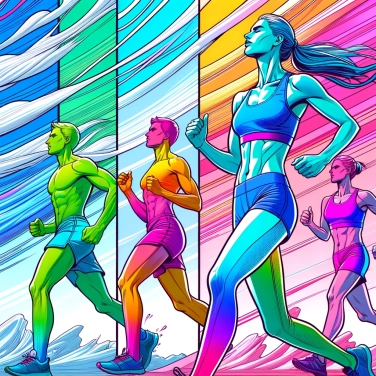Dark-colored clothes absorb more heat from the sun than light-colored clothes, which can increase body temperature when exposed directly to sunlight during physical activity.

Dark colors absorb more heat emitted by the sun, which quickly increases body temperature. In contrast, light shades reflect a large portion of light rays and therefore heat up significantly less. Specifically, a black t-shirt worn in the sun will heat up much faster than a garment in white or pastel colors, which will keep the body cooler during physical activity. Therefore, choosing your outfit carefully allows for better temperature regulation and improves performance and comfort.
Light colors like white reflect a good portion of the sun's rays, which limits thermal absorption. In contrast, dark-colored clothing, such as black or navy blue, absorbs more solar rays and therefore accumulates heat more quickly beneath their surface. Moreover, after absorbing heat, dark fabrics have more difficulty releasing it back to the outside: they are said to have a low thermal emission capacity. In practical terms, if you wear black in the sun, you are likely to heat up much faster than if you wear white or light yellow, which are much better at not retaining heat unnecessarily.
When it is hot and sunny, opt for lighter colors like white, beige, or pale yellow: they reflect sunlight better, so you heat up much less quickly. Conversely, in cool or cold weather, dark shades like black, navy, or dark gray will help you absorb sunlight and thus retain a bit more body heat. Depending on conditions like wind or high humidity, choose your color wisely to comfortably enjoy your sports activity without overheating or shivering unnecessarily.
Some current sports textiles use innovative technologies that play on both the material composition and colored pigments. The goal: to improve the body's thermal regulation. For example, fibers with thermochromic pigments change color according to temperature. If you overheat during exertion, they become lighter to better reflect sunlight and help you cool down. Conversely, when your body cools down, they shift to darker shades to absorb more heat and maintain your body temperature. Fabrics with integrated thermal microcapsules also work very well: they capture and gently release heat according to your needs. This kind of innovation enhances both your comfort during sports activities and your physical performance.
To stay cool under a strong sun, choose colors like white, pale yellow, or light blue: these shades reflect more sunlight and keep heat away from the body. Conversely, for a sports outing in a cold climate, opt for darker colors like black, navy blue, or dark green: they absorb radiation better and can help your body retain heat. Also consider the sporting activity: for intense running where you sweat easily, prefer light colors, even in moderately warm weather. Finally, if you're hiking in the mountains with significant temperature fluctuations, planning for a light outer layer and a dark inner layer is a simple trick that works quite well.
Changing clothing colors according to the time of day or the weather can reduce the body's energy loss related to thermoregulation, thereby allowing for better long-term athletic performance.
Wearing white or very light-colored clothing not only reflects sunlight rays but also improves visibility, thereby increasing safety during outdoor sports activities.
Some modern sportswear features special pigments that can reflect infrared radiation, thereby reducing the perceived body temperature even when wearing traditionally warming colors.
Light blue is an excellent option for balancing solar reflection and heat transmission through evaporation. It is a highly favored color for sports activities in warm climates.
In changing conditions, prioritize layering garments in light and intermediate colors to ensure optimal flexibility. Also, choose breathable and lightweight technical fabrics that allow for effective temperature and moisture management.
Yes, dark clothing absorbs solar rays more effectively, which helps to warm the body in cold or winter conditions. This can provide additional thermal comfort for athletes training outdoors during this time.
Yes, these colors provide intermediate levels of thermal performance between black and white. Generally, the darker the color, the more it will absorb radiation, while a lighter color tends to reflect it more.
Indirectly, yes. By influencing body temperature and thus thermal comfort, the color of clothing can play a role in maintaining an optimal temperature and thereby help preserve endurance, concentration, and consequently, sports performance.
Light colors, and particularly white, reflect more solar rays, thus reducing heat accumulation and helping to maintain a more stable body temperature during exertion.

No one has answered this quiz yet, be the first!' :-)
Question 1/5